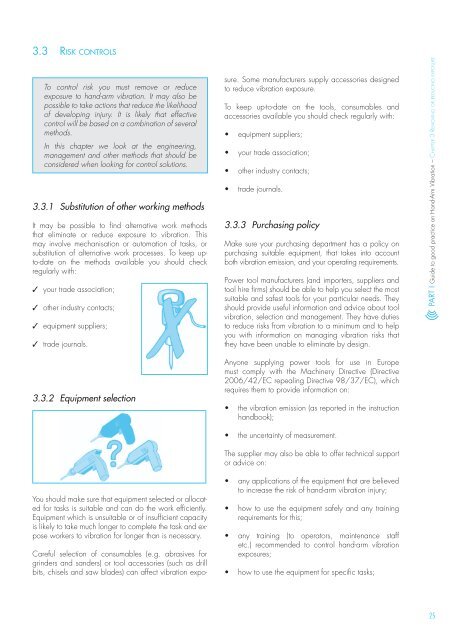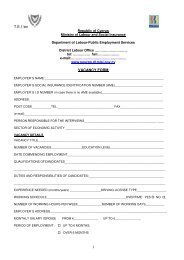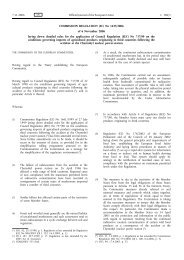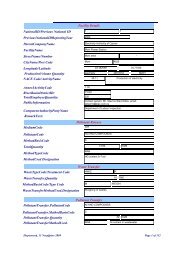Non binding guide to good practice for implementing Directive
Non binding guide to good practice for implementing Directive
Non binding guide to good practice for implementing Directive
- No tags were found...
You also want an ePaper? Increase the reach of your titles
YUMPU automatically turns print PDFs into web optimized ePapers that Google loves.
3.3 RISK CONTROLSTo control risk you must remove or reduceexposure <strong>to</strong> hand-arm vibration. It may also bepossible <strong>to</strong> take actions that reduce the likelihoodof developing injury. It is likely that effectivecontrol will be based on a combination of severalmethods.In this chapter we look at the engineering,management and other methods that should beconsidered when looking <strong>for</strong> control solutions.3.3.1 Substitution of other working methodsIt may be possible <strong>to</strong> fi nd alternative work methodsthat eliminate or reduce exposure <strong>to</strong> vibration. Thismay involve mechanisation or au<strong>to</strong>mation of tasks, orsubstitution of alternative work processes. To keep up<strong>to</strong>-dateon the methods available you should checkregularly with:✓ your trade association;✓ other industry contacts;✓ equipment suppliers;✓ trade journals.Careful selection of consumables (e.g. abrasives <strong>for</strong>grinders and sanders) or <strong>to</strong>ol accessories (such as drillbits, chisels and saw blades) can affect vibration exposure.Some manufacturers supply accessories designed<strong>to</strong> reduce vibration exposure.To keep up-<strong>to</strong>-date on the <strong>to</strong>ols, consumables andaccessories available you should check regularly with:• equipment suppliers;• your trade association;• other industry contacts;• trade journals.3.3.3 Purchasing policyMake sure your purchasing department has a policy onpurchasing suitable equipment, that takes in<strong>to</strong> accountboth vibration emission, and your operating requirements.Power <strong>to</strong>ol manufacturers (and importers, suppliers and<strong>to</strong>ol hire fi rms) should be able <strong>to</strong> help you select the mostsuitable and safest <strong>to</strong>ols <strong>for</strong> your particular needs. Theyshould provide useful in<strong>for</strong>mation and advice about <strong>to</strong>olvibration, selection and management. They have duties<strong>to</strong> reduce risks from vibration <strong>to</strong> a minimum and <strong>to</strong> helpyou with in<strong>for</strong>mation on managing vibration risks thatthey have been unable <strong>to</strong> eliminate by design.PART I Guide <strong>to</strong> <strong>good</strong> <strong>practice</strong> on Hand-Arm Vibration – CHAPTER 3 REMOVING OR REDUCING EXPOSURE3.3.2 Equipment selectionYou should make sure that equipment selected or allocated<strong>for</strong> tasks is suitable and can do the work effi ciently.Equipment which is unsuitable or of insuffi cient capacityis likely <strong>to</strong> take much longer <strong>to</strong> complete the task and exposeworkers <strong>to</strong> vibration <strong>for</strong> longer than is necessary.Anyone supplying power <strong>to</strong>ols <strong>for</strong> use in Europemust comply with the Machinery <strong>Directive</strong> (<strong>Directive</strong>2006/42/EC repealing <strong>Directive</strong> 98/37/EC), whichrequires them <strong>to</strong> provide in<strong>for</strong>mation on:• the vibration emission (as reported in the instructionhandbook);• the uncertainty of measurement.The supplier may also be able <strong>to</strong> offer technical suppor<strong>to</strong>r advice on:• any applications of the equipment that are believed<strong>to</strong> increase the risk of hand-arm vibration injury;• how <strong>to</strong> use the equipment safely and any trainingrequirements <strong>for</strong> this;• any training (<strong>to</strong> opera<strong>to</strong>rs, maintenance staffetc.) recommended <strong>to</strong> control hand-arm vibrationexposures;• how <strong>to</strong> use the equipment <strong>for</strong> specifi c tasks;25










![Hadjimichael[1].pdf](https://img.yumpu.com/33937965/1/190x135/hadjimichael1pdf.jpg?quality=85)





